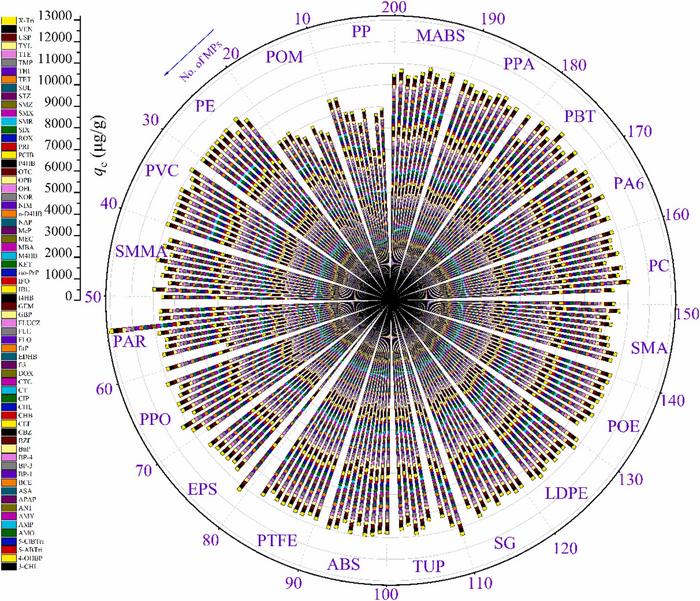Predicting potential problems of persistent plastic particulates
SUTD - Hui Ying Yang
CSU - Jingjing Yao, Haipu Li
Plastics monopolise our household accessories due to their low cost and versatility. Unfortunately, the lack of proper disposal measures has led to widespread proliferation of these non-biodegradables into the natural environment. Although plastics do not generally break down via biological processes, they age and disintegrate via chemical reactions.
The resulting waste, dubbed microplastics for their size, make their way into the ocean and circulate back into our water supply. The long-term persistence of microplastics is harmful because they can adsorb - or bind - onto other waste products. In particular, chemical waste consumables can interact with microplastics in unforeseen and potentially harmful ways. Dubbed pharmaceuticals and personal care products (PPCPs), these emerging chemical contaminants are dangerous in their ability to present physiological effects in humans at low doses.
Professor Yang Hui Ying from the Engineering Product Development pillar at the Singapore University of Technology and Design (SUTD) has observed that the current literature on long-term ageing treatments of microplastics is inadequate. Most research only looks at short-term ageing, which may not fully reflect the environmental behaviour of microplastics.
She shared the difficulties involved in modelling the environmental dynamics, "Due to the various ageing processes experienced by microplastics and the complexity of adsorption processes and mechanisms of different PPCPs on microplastics, distinguishing these adsorption differences solely through experimental methods can be challenging."
Together with collaborators from China, Prof Yang looked to utilising modern machine learning techniques to overcome this hurdle. They published their paper 'Predicting adsorption capacity of pharmaceuticals and personal care products on long-term aged microplastics using machine learning' in the Journal of Hazardous Materials.
Previous studies have developed techniques for predicting adsorption capacity between PPCPs and microplastics to varying levels of success, using quantum chemical descriptors. However, these studies are often impractical to carry out due to their limited accuracy and time-consuming nature. In particular, they neglect the surface effects of microplastics, which are important when modelling adsorption behaviours.
 Adsorption capacity (qe) of each PPCP on each MP
Adsorption capacity (qe) of each PPCP on each MP
To address this limitation, Prof Yang used Fourier-transform infrared (FT-IR) spectroscopy. This technique allowed her to probe the surface of microplastics carefully, identifying different functional groups and how they influence interactions with surrounding chemicals. Linking the adsorption behaviour to the FT-IR of microplastics is important, but previous established models for studying interactions between microplastics and PPCPs had not incorporated this information. As such, Prof Yang decided to turn to machine learning.
"Machine learning can derive general conclusions, identify key roles, and discover potential patterns from complex data without relying on prior knowledge. This implies that we can gain a deeper understanding of the intricate interactions between microplastics and PPCPs, offering new insights and solutions to safeguard ecosystems," said Prof Yang, highlighting the power of using the right tools.
The next step was to pick a suitable machine learning model to capture the multidimensional dynamics of the adsorption process. A strong algorithm for classification problems, the gradient-boosting decision tree (GBDT) is a popular choice for prediction tasks. However, applying it onto the intricate and subtle task of distinguishing various complex adsorption behaviours proved challenging. Prof Yang and team then considered the maximal information coefficient (MIC) to observe dependencies between variables, accounting for the affinity between the functional groups on microplastics and the contaminant PPCPs. Integrating the two approaches with FT-IR data became the ideal approach in predicting aged microplastics behaviour.
To collect data for their machine learning model, the researchers marinated microplastic particles in a blend of chemicals to simulate the ageing process. The concoction was periodically sampled during ageing to observe longitudinal effects. In the study, the team took samples up to nearly two years from their initial proposal to ensure that proper adsorption behaviours were observed.
The team was able to attribute various dynamics between the microplastics and PPCPs to various well-studied mechanisms from correlations to quantum chemistry models. The FT-IR data allowed the team to observe the most prominent functional groups involved in the adsorption. With these insights in hand, their machine learning model captured the complexity of the system with up to 98% accuracy during training and 70% on test data.
"What amplifies its significance is our ability to forecast the adsorption quantities of various PPCPs on aged microplastics in real-world aquatic environments," Prof Yang described.
This study shines an illuminating torch on the scene of microplastics, serving as a crucial reference for future assessments. Prof Yang is also hopeful in its potential to assist relevant authorities in identifying key pollutants for targeted pollution control strategies.
Looking ahead, the researchers plan to explore the next stage in the microplastic adsorption life cycle. A comprehensive evaluation in the release of organic substances from microplastics are in the works, to assess the long-term impact of the persistent plastic particulates. Prof Yang aspires to cast light on the complex dynamics between microplastics and pollutants, quantify their impact, and make substantial contributions to environmental awareness and policy formulation.
Reference:
Predicting adsorption capacity of pharmaceuticals and personal care products on long-term aged microplastics using machine learning, Journal of Hazardous Materials. (DOI: 10.1016/j.jhazmat.2023.131963)